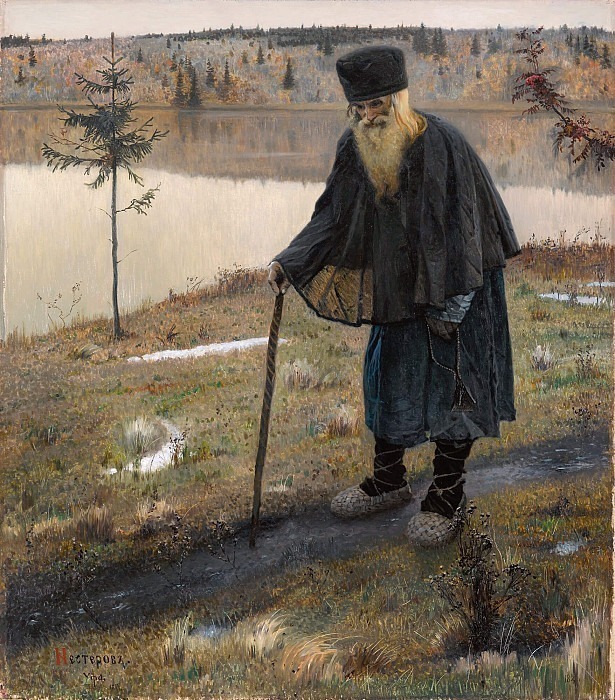Hermit Mikhail Nesterov (1862-1942)
Mikhail Nesterov – Hermit
Edit attribution
Download full size: 1756×2000 px (0,5 Mb)
Painter: Mikhail Nesterov
Location: The State Tretyakov Gallery, Moscow (Государственная Третьяковская галерея).
The title for the painting was not chosen by the author by chance. The title refers to a wanderer, a traveler, a wayfarer, a hermit. The main character in the painting is a white-haired man. He has long hair and a beard. He is dressed lightly enough, despite the fact that in some places there is still snow on the street. It’s mid-spring, and the ice on the river has already melted. The smooth surface of the water is like a mirror, reflecting the cloudy sky. A man is walking along the bank.
Description of Mikhail Nesterov’s painting The Hermit
The title for the painting was not chosen by the author by chance. The title refers to a wanderer, a traveler, a wayfarer, a hermit. The main character in the painting is a white-haired man. He has long hair and a beard. He is dressed lightly enough, despite the fact that in some places there is still snow on the street. It’s mid-spring, and the ice on the river has already melted. The smooth surface of the water is like a mirror, reflecting the cloudy sky.
A man is walking along the bank. There is a thick cloud cover on the sky. Winter never dares to leave its domain, so the sky, alas, is still overcast. And a rare ray can penetrate their veil. Bare, damp earth. It’s quiet and smooth, but it’s not at all comfortable. You can feel the chill of the day. A cold wind blows from the river, a light rain falls - the vicissitudes of the weather at this time are taken for granted.
But it doesn’t matter to the old man. He feels good and happy, even in this environment. He walks and smiles - he does not care about this cold. His boots are soaked, and he is not dressed as warmly as he should. But he walks and smiles at what he sees. He is happy, because all the laws of nature, the change of seasons, are unchangeable and constant. And after the cold, warmth is sure to come. He appreciates every moment of this life. His wisdom allows him to find something especially beautiful in any weather, not to grumble about the cold and rain, but to enjoy the uniqueness of the moment, its peculiarity, because he is the only such amazing and unique moment, and this moment will never be repeated.
The shadow of the elder monk right in front of him means that the sun is shining behind him. He is just like everyone else, an ordinary man of flesh and blood. But at the same time he is totally different, spiritually dissenting. Years of worshipping the Lord, his cross of repentance and obedience have given him wisdom and tolerance, with which he has a special path that only he knows and understands. A path that leads to happiness.
Кому понравилось
Пожалуйста, подождите
На эту операцию может потребоваться несколько секунд.
Информация появится в новом окне,
если открытие новых окон не запрещено в настройках вашего браузера.
You need to login
Для работы с коллекциями – пожалуйста, войдите в аккаунт (open in new window).



















COMMENTS: 1 Ответы
ПРАВОСЛАВИЕ
Православья пёстрые цвета,
И цветы духовного пошиба.
Храм в себя вбирает высота.
Воплощеньем красоты красиво
Предстаёт любой из храмов. Но
Заходить порою очень стыдно,
Ибо сущность веры не дано
Осознать, мечтая: жизнь – повидло.
Копьецо свечи – огонь горит,
И шатры свечей. Иконы смотрят
Прямо в душу мне, и мне – горчит
От подобных взглядов. Давит опыт.
Я к иконостасу подойду,
Православья толком и не зная.
Но быть может в храме обрету
Свет, свои амбиции теряя.
You cannot comment Why?
The painting evokes a sense of solitude, contemplation, and spiritual journey. The hermits posture and gaze suggest introspection, perhaps reflecting on his life or on matters of faith. The subdued autumn palette and the vast, quiet landscape contribute to an atmosphere of peace and solitude, but also hints at the end of a cycle, aligning with the hermits advanced age and his withdrawal from the world. The presence of the natural elements – the lake, trees, and the changing season – can be interpreted as metaphors for the transient nature of life and the cyclical processes of existence. The painting invites viewers to reflect on themes of aging, spirituality, and the search for meaning in isolation.